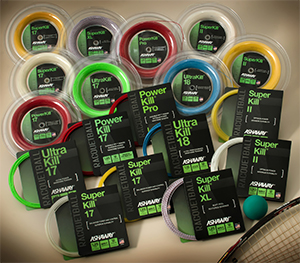|
|

The Design and Performance of Nylon Racquetball Strings
By Steve Crandall
Vice President, Sales & Marketing
Ashaway Racket Strings

As the official string of USA Racquetball (and the only string made in the USA), Ashaway works continually to improve its broad line of racquetball strings to help you improve your game. |
In our last column (Winter 2015) we looked at the properties of Zyex® as used in racquetball string. This time, we'll look at the world's most popular racquet string material, Nylon, or as it is also called, synthetic gut.
A bit of history: Nylon is one of the oldest polymers around, having been invented by DuPont scientist Wallace Carothers in 1935. Considered a "do anything" material, various nylon compounds have been used in everything from nylon stockings to machine bearings, automotive parts and boat anchor line. The first multifilament nylon tennis string was developed by Ashaway in 1949, and the first multifilament nylon racquetball string - Ashaway's original SuperKill® - appeared in the mid-70s. Today, despite decades of 'space age' material innovation, nylon remains the most popular string material for squash, tennis, racquetball, and badminton.
In racquetball, nylon has been the dominant string material since the game first began its rise to popularity in the early 1970s. Gut never made it as a contender - despite having a very racquetball-sounding name - and only in recent years have newer, space-age materials like Zyex® begun to replace nylon in our racquets.
There are several reasons for the long popularity of nylon strings. They are relatively inexpensive compared to other high tech synthetics. They are very responsive. They are not sensitive to moisture (or other chemicals), and they provide good abrasion resistance. In studies conducted by USRSA, the dynamic stiffness ratings for several nylon string brands were approximately 190 lb./in, which is quite respectably low compared to Zyex at 145. Nylon's main drawback is that it loses tension and wears more quickly than other string materials leading to a shorter life in the racquet.
Although it doesn't spring back quite as quickly as Zyex, nylon stretches more, so the amount of power it generates is comparable. In fact, depending on the design and gauge of the string, nylon can be either quite stretchy or quite stiff. Nylon is also quite versatile, providing players with a range of characteristics, and is often cited for its playability and feel. Nylon strings are still the standard for beginning players, and have been used by just about everybody who has ever played the game, including the world's top professionals.
String designers use nylon's broad range of properties for different purposes. When used as a string core, nylon provides a great deal of resilience. Multifilament cores are made from thousands of very thin fibers twisted and/or braided together, but not chemically bonded: they're free to stretch somewhat independently of one another. As a result, multifilament cores are less stiff, i.e., more resilient than monofilament cores of the same material. And resiliency, as we know, generates power.
Nylon is also used in the outer jacket, or wear layer, on most strings, including those with Zyex cores. For this usage, string designers often choose a harder, less resilient monofilament nylon fiber to resist wear and to protect the core fibers from notching during heavy play. Some designs, like our SuperKill XL string, include a textured surface on the wear layer, greatly enhancing ball control and adding another degree of playability.
But the story of nylon racquetball strings has been evolving with the sport for over 40 years. As racquet head designs and styles of play have changed, so have manufacturers expanded and enhanced their string offerings to meet the needs of a broad spectrum of players. For example, our original SuperKill string - now called SuperKill II - is a real heavyweight at 1.3 mm, or 16 gauge. It has a monofilament nylon core wrapped in a tough nylon wear surface offers both power and durability with excellent resiliency, standing up to even the most powerful strokes.
As the sport matured in the late 1980s and 90s and players began to demand thinner strings, along with more power and ball control, we developed SuperKill 17. Also built on a monofilament core, SuperKill 17 is 1.25 mm in diameter (17 gauge) and offers an excellent balance of power and ball control, along with superior resiliency and above average durability. Designed for optimum playability at all skill levels, SuperKill 17 was used exclusively by several top touring pros in the 1990s.
Introduced in the early 2000s, SuperKill XL incorporates a multifilament nylon core and is designed to provide a softer feel with excellent response and resiliency. Also 1.25 mm (17 gauge), SuperKill XL is a thin lively string that provides enhanced grip on the ball and shot placement. It is used by many top players looking to optimize power, touch and ball control.
Finally, as we noted last time, we have recently combined a multifilament nylon core with a specially woven Zyex wear layer to produce yet another variation in the evolution of nylon racquetball strings, our PowerKill® family. Originally intended simply to improve tension holding, we were surprised to find that this new combination also increased the power and durability of the string, yet still retained that soft nylon "touch" and playability so many players favor. Who knew?
Which, when you come down to it, is really the point. Even though nylon has been around for some 80 years now, we don't know what else may be possible: a new weave or core combination, a new formulation or additive, even a new surface texture may open up new possibilities and playing characteristics. That's why we keep working: as the official string of USA Racquetball (and the only string made in the USA), we want to continually improve our string offerings to help you improve your game.
ZYEX® is a registered trademark of Victrex Ltd.
|